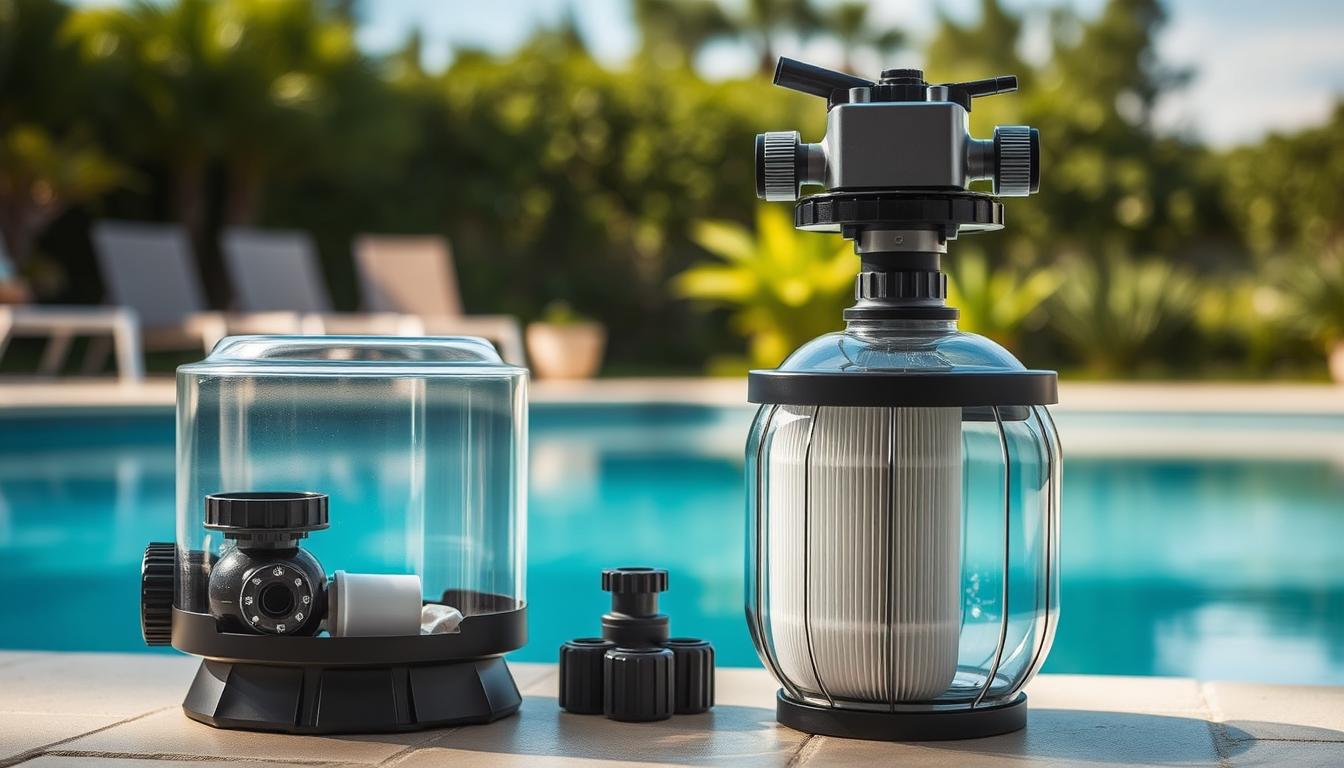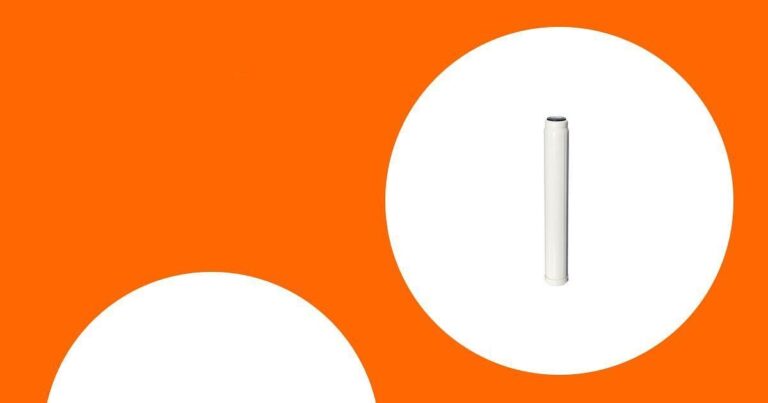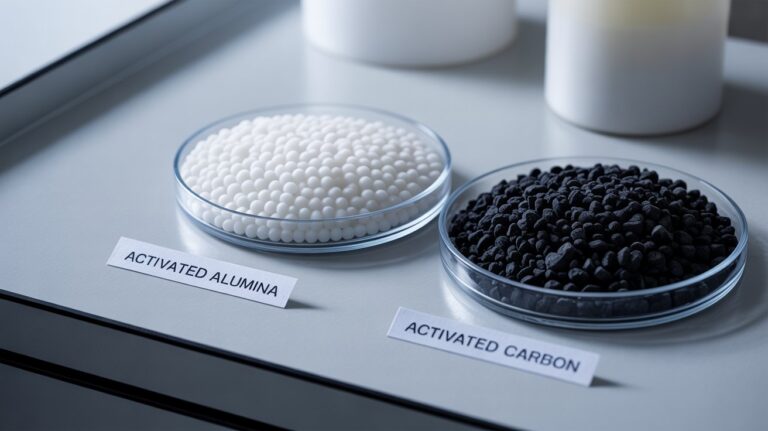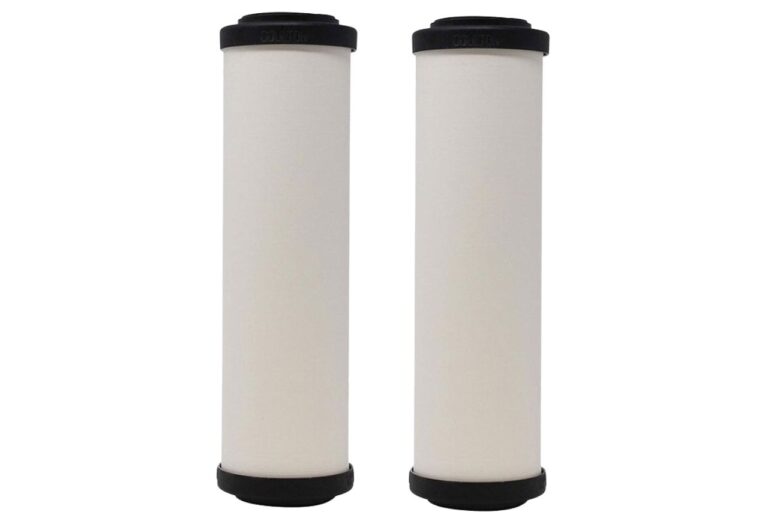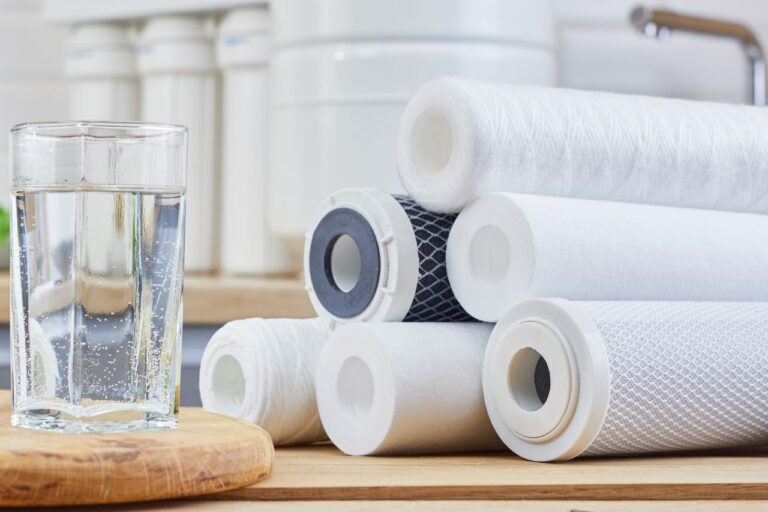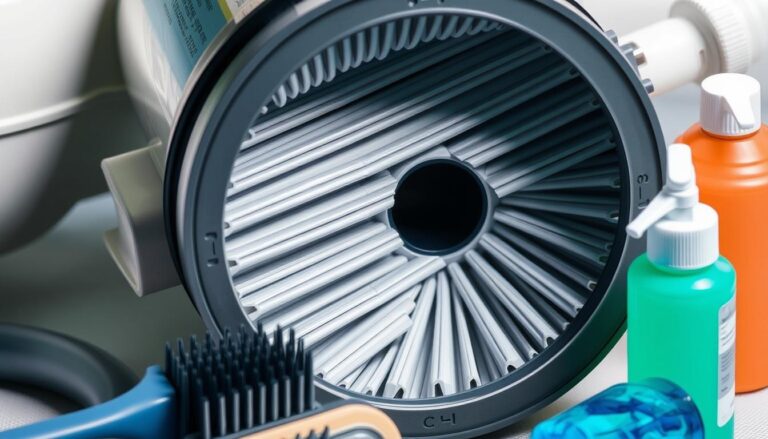DIY Pool Filter Cleaner: Easy Steps to Clean It Yourself
Are you tired of cloudy pool water and strained equipment due to a dirty filter? Regular maintenance is key to ensuring your pool remains clean and safe for users.
Cleaning your pool filter regularly is essential, and it’s recommended to do so at least once a month, with a deep clean at least once a year. By following our DIY guide, you can save money and keep your pool in top condition.
A dirty filter can lead to a range of issues, including cloudy water and equipment strain. Our guide will walk you through the process of making a homemade pool filter cleaner and provide easy steps to clean your filter yourself.
Key Takeaways
- Learn how to clean your pool filter regularly to maintain clean and safe pool water.
- Discover the benefits of making a homemade pool filter cleaner.
- Follow easy steps to deep clean your filter at least once a year.
- Save money by taking a DIY approach to pool filter maintenance.
- Keep your pool equipment running smoothly and efficiently.
Why Regular Pool Filter Cleaning Is Essential
A clean pool filter is the backbone of a well-maintained pool, ensuring clear water and efficient operation. Regular cleaning of your pool filter is vital for maintaining good water quality and preventing equipment damage.
The Impact of Dirty Filters on Pool Health
Dirty filters can lead to a range of problems, including cloudy water and eye irritation. When the filter is clogged, it can’t effectively remove dirt and debris from the water.
Water Quality Issues
A dirty filter compromises water quality, leading to cloudy or murky water. This not only affects the aesthetic appeal of your pool but also poses health risks to swimmers.
Equipment Strain and Damage
When the filter is clogged, the pump has to work harder, leading to increased strain on the equipment. This can result in premature wear and tear, potentially causing costly damage.
How Clean Filters Save You Money
By keeping your filter clean, you can significantly reduce energy consumption and extend the lifespan of your equipment, leading to cost savings.
Reduced Energy Consumption
A clean filter allows your pump to operate more efficiently, reducing the energy required to circulate the water. This leads to lower utility bills and a reduced carbon footprint.
Extended Equipment Lifespan
Regular filter cleaning reduces the strain on your pool equipment, prolonging its lifespan and delaying the need for costly replacements.
| Benefits of Regular Filter Cleaning | Impact on Pool Maintenance |
|---|---|
| Improved Water Quality | Clear and safe water for swimmers |
| Reduced Energy Consumption | Lower utility bills and reduced carbon footprint |
| Extended Equipment Lifespan | Delayed need for costly equipment replacements |
Understanding Different Types of Pool Filters
The key to a well-functioning pool lies in its filtration system, and there are three primary types to consider. Understanding these differences is crucial for effective maintenance and choosing the right pool cleaning solutions.
Sand Filters
Sand filters are a popular choice among pool owners. They use sand to filter out dirt and debris from the water.
How They Work
The sand traps dirt and debris, allowing clean water to pass through. This process requires regular backwashing to remove trapped dirt.
Cleaning Challenges
One of the challenges with sand filters is maintaining the sand’s effectiveness over time. The sand needs to be replaced every 5-7 years.
Cartridge Filters
Cartridge filters offer a different approach to pool filtration. They use a replaceable cartridge to clean the water.
Design and Functionality
These filters are known for their ease of use and efficiency in trapping small particles.
Maintenance Requirements
Regular cleaning of the cartridge is necessary, and it should be replaced as recommended by the manufacturer.
Diatomaceous Earth (DE) Filters
DE filters are renowned for their superior filtration capabilities, using a powder made from fossilized algae.
Filtration Benefits
They can trap very fine particles, making them ideal for pools requiring high clarity water.
Special Cleaning Considerations
Cleaning DE filters involves backwashing and recharging with new DE powder. This process can be more labor-intensive but yields excellent results.
| Filter Type | Maintenance Frequency | Filtration Efficiency |
|---|---|---|
| Sand Filters | Backwash every 1-2 weeks | Good |
| Cartridge Filters | Clean every 2-4 weeks | Very Good |
| DE Filters | Backwash and recharge every 1-2 months | Excellent |
Choosing the right DIY pool filter cleaner depends on understanding your pool’s filter type. Using a natural pool filter cleaner can be beneficial for both the environment and the longevity of your pool equipment.
Commercial vs. Homemade Pool Filter Cleaners
When it comes to maintaining your pool, the choice between commercial and homemade pool filter cleaners can significantly impact both your wallet and the environment. Many commercial pool filter cleaners are available, but making your own cleaner can be a cost-effective and environmentally friendly alternative.
Cost Comparison
The cost of commercial pool filter cleaners can add up over time. In contrast, homemade cleaners often utilize household items, making them a more economical choice.
Short-term vs. Long-term Savings
While commercial cleaners may seem affordable in the short term, the long-term costs can be substantial. Homemade cleaners, though requiring initial effort, can lead to significant long-term savings.
Effectiveness Analysis
The effectiveness of a pool filter cleaner is paramount. Commercial cleaners are often formulated for specific types of filters and can be quite effective. However, homemade solutions can also be tailored to the type of filter you have, offering a comparable cleaning power.
Cleaning Power Differences
The difference in cleaning power between commercial and homemade cleaners can be minimal if the homemade solution is correctly formulated. It’s essential to understand the type of debris your filter accumulates to create an effective homemade cleaner.
Environmental Considerations
Using homemade pool filter cleaners can reduce the environmental impact associated with the production and disposal of commercial cleaning products.
Chemical Impact on Water Systems
Commercial cleaners can contain harsh chemicals that may harm local water systems if not disposed of properly. Homemade cleaners, when made with eco-friendly ingredients, offer a greener alternative.
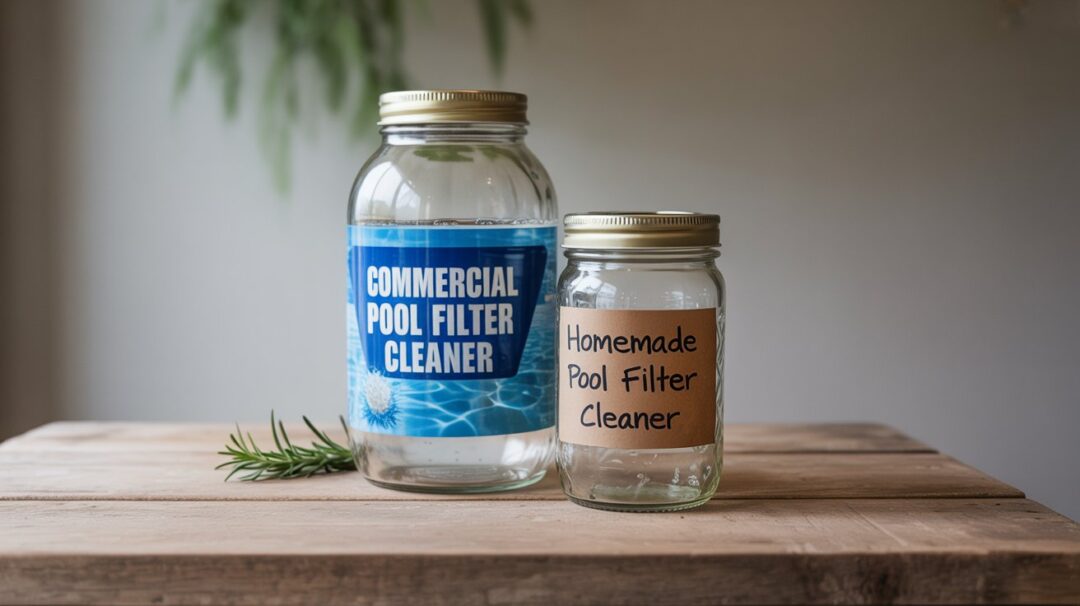
Essential Ingredients for DIY Pool Filter Cleaners
To make an effective natural pool filter cleaner, you’ll need to gather a few simple household items. The beauty of DIY pool cleaning solutions lies in their simplicity and the use of readily available ingredients.
Common Household Items You Can Use
Many effective cleaning agents can be found right in your kitchen or pantry. For instance, vinegar and baking soda are staples for many DIY cleaning projects, including pool filter cleaning.
Vinegar and Baking Soda Solutions
A mixture of vinegar and baking soda can create a powerful cleaning solution. The acid in the vinegar helps break down dirt and grime, while the baking soda acts as a gentle abrasive. To make this solution, mix 1 cup of vinegar with 1 tablespoon of baking soda. Let it sit for a few hours before rinsing.
Dish Soap Applications
Mild dish soap can also be used to clean pool filters. It’s essential to choose a soap that is free from harsh chemicals and abrasives to avoid damaging the filter. Mix a small amount of dish soap with warm water, and soak the filter before rinsing thoroughly.
Eco-Friendly Alternatives
For those looking for even greener options, citrus-based cleaners are an excellent alternative. These cleaners are not only effective but also environmentally friendly.
Citrus-Based Cleaners
Citrus-based cleaners, made from citrus peels and natural solvents, are a potent and eco-friendly option. They are biodegradable and can be just as effective as chemical-based cleaners.
What Ingredients to Avoid
While many household items can be used to clean pool filters, there are some ingredients you should avoid. Certain chemicals can damage the filter or disrupt the pool’s water balance.
Harmful Chemicals for Filters
Avoid using bleach or harsh chemical cleaners, as they can damage the filter materials. Similarly, abrasive cleaners can scratch or wear down the filter components.
Pool Water Balance Disruptors
Some cleaning agents can alter the chemical balance of your pool water. Avoid using products that contain high levels of phosphates or other chemicals that can lead to algae growth or other issues.
Here’s a comparison of the ingredients discussed:
| Ingredient | Effectiveness | Eco-Friendliness |
|---|---|---|
| Vinegar & Baking Soda | High | High |
| Dish Soap | Moderate | Moderate |
| Citrus-Based Cleaners | High | High |
How to Make Your Own Pool Filter Cleaner: Basic Recipes
Making your own pool filter cleaner at home is easier than you might think. With a few simple ingredients, you can create effective cleaning solutions tailored to your pool’s needs.
All-Purpose DIY Filter Cleaner
For a basic cleaner, you can mix trisodium phosphate (TSP) with water. This all-purpose solution is effective for regular filter maintenance.
Ingredients and Measurements
To make this cleaner, you’ll need 1 cup of TSP and 1 gallon of warm water. Ensure you mix it in a well-ventilated area and wear protective gloves.
Mixing Instructions
Slowly add the TSP to the water, stirring until it’s fully dissolved. This mixture can be used immediately.
Heavy-Duty Cleaning Solution
For severely soiled filters, a mixture of muriatic acid and water can be used. This solution is more potent and should be handled with caution.
For Severely Soiled Filters
Mix 1 part muriatic acid with 10 parts water. Always add the acid to the water, never the other way around, to prevent dangerous splashing.
Storage and Shelf Life
Store this solution in a labeled, acid-resistant container. It can be kept for up to 6 months, but it’s best used fresh.
Gentle Cleaner for Sensitive Materials
If your filter is made of sensitive materials, a gentle cleaner can be made using baking soda and water.
Non-Abrasive Formula
Mix 1 cup of baking soda with 1 gallon of warm water to create a non-abrasive cleaning solution.
Application Techniques
Soak the filter in this solution for a few hours before rinsing thoroughly. This method is safe for most filter types.
Step-by-Step Guide to Cleaning Cartridge Filters
To keep your pool water crystal clear, it’s essential to know how to clean cartridge filters effectively. Cleaning your cartridge filter is a straightforward process that involves several key steps.
Removing and Preparing the Filter
Before you start cleaning, ensure you turn off the pool pump to avoid any accidents. Safety first is a mantra to remember when working with electrical equipment near water.
Safety Precautions
Always switch off the power to your pool pump at the circuit breaker or fuse box before starting the cleaning process. Verify that the pump is completely stopped before proceeding.
Initial Rinse Techniques
Gently remove the cartridge filter from its housing and rinse it with a garden hose to remove any loose debris. This initial rinse helps prevent clogging during the soaking process.
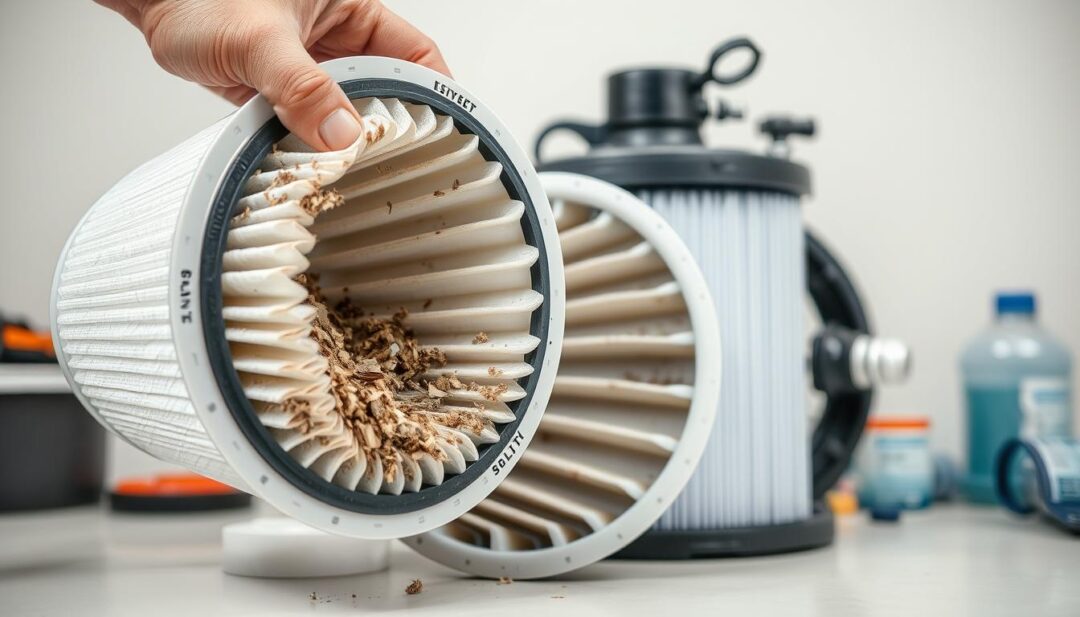
Applying Your Homemade Cleaner
For a deeper clean, apply your DIY pool filter cleaner to the cartridge filter. You can either soak the filter or spray the cleaner directly onto it.
Soaking Methods
Submerge the filter in a bucket filled with your cleaning solution, making sure the filter is fully covered. Let it soak for several hours or overnight for tough grime.
Spray Application Tips
If soaking isn’t feasible, spray your DIY cleaner onto the filter, ensuring both sides are coated. Let it sit for a while before rinsing.
Rinsing and Reinstalling
After applying the cleaner, thoroughly rinse the filter with a garden hose to remove any remaining dirt and cleaning solution.
Thorough Cleaning Verification
Inspect the filter for any remaining debris. If it’s still dirty, consider repeating the cleaning process.
Proper Reassembly Steps
Once clean, reinstall the cartridge filter into its housing, ensuring it’s securely locked in place. Turn the power back on and check for leaks.
| Step | Description | Tips |
|---|---|---|
| 1. Remove Filter | Take out the cartridge filter from its housing. | Be gentle to avoid damage. |
| 2. Initial Rinse | Rinse with a garden hose. | Remove loose debris. |
| 3. Apply Cleaner | Use DIY pool filter cleaner. | Soak or spray. |
| 4. Rinse and Reinstall | Rinse thoroughly and put back. | Check for leaks. |
Cleaning Sand and DE Filters with Homemade Solutions
Maintaining sand and DE filters is crucial for a clean and healthy pool environment. These filters, while effective, require regular cleaning to function at their best. Using homemade solutions can be a cost-effective and environmentally friendly way to keep your pool filters in top condition.
Backwashing Techniques
Backwashing is a critical step in maintaining sand and DE filters. It involves reversing the flow of water through the filter to remove dirt and debris.
Optimal Pressure Readings
It’s essential to monitor the pressure gauge during backwashing. The ideal pressure reading varies by filter, but generally, you’re looking for a drop in pressure after backwashing. Typically, a 10-20 psi drop is considered effective.
Frequency Guidelines
How often you backwash depends on the filter type and pool usage. For sand filters, backwashing every 1-2 weeks during peak season is common. DE filters may require more frequent backwashing, especially after heavy use.
Deep Cleaning Methods
While backwashing is routine maintenance, deep cleaning is necessary to rejuvenate your filter.
Sand Filter Rejuvenation
For sand filters, deep cleaning involves using a filter cleaner to break down oils and debris that backwashing can’t remove. A homemade cleaner made from household items can be just as effective as commercial products.
DE Grid Cleaning Process
DE filters require disassembly and manual cleaning of the grids. Soaking them in a solution of water and a homemade cleaner can help remove built-up debris.
Maintenance Tips
Regular maintenance can prevent issues like channeling in sand filters and reduce the need for frequent DE powder replacement.
Preventing Channeling in Sand Filters
Channeling occurs when dirt creates pathways through the sand, reducing filter efficiency. Regular backwashing and occasional deep cleaning can prevent this.
DE Powder Replacement Guide
For DE filters, recharging with new DE powder after cleaning is crucial. The frequency of replacement depends on usage, but generally, it’s done after every few backwashes.
Safety Considerations When Cleaning Pool Filters
Cleaning your pool filter is a task that requires attention to safety to avoid accidents and ensure a healthy swimming environment. Handling potentially hazardous chemicals and working with equipment under pressure demand careful consideration of several safety factors.
Handling Cleaning Chemicals Safely
When using cleaning chemicals, it’s crucial to wear protective equipment to prevent skin and eye irritation. This includes gloves, goggles, and sometimes a mask to avoid inhaling fumes.
Protective Equipment Recommendations
Always choose gloves that are resistant to the chemicals you’re using. Goggles should fit snugly around your eyes. Consider the type of cleaning solution and the potential for splashing when selecting your protective gear.
Ventilation Requirements
Ensure the area is well-ventilated when working with cleaning chemicals to prevent the buildup of harmful fumes. Open windows or use a fan to circulate the air.
Proper Disposal of Cleaning Solutions
After cleaning your pool filter, it’s essential to dispose of the used cleaning solution properly to avoid environmental harm. Check the label for specific disposal instructions.
Environmental Guidelines
Never pour cleaning chemicals down storm drains or into the ground, as they can contaminate water sources. Instead, follow local guidelines for hazardous waste disposal.
Local Regulations
Be aware of local regulations regarding the disposal of chemical waste. Some communities have specific collection days for hazardous waste.
Equipment Pressure Warnings
Be cautious when working with pool filter equipment under pressure. Sudden releases of pressure can cause injury.
Preventing System Damage
Follow the manufacturer’s instructions for cleaning and maintaining your pool filter to prevent system damage.
Personal Safety Measures
Ensure you’re familiar with the emergency shutdown procedure for your pool filter system in case something goes wrong during cleaning.
Troubleshooting Common Filter Cleaning Problems
Troubleshooting common filter cleaning problems is essential to maintaining a healthy and clean pool. Even with regular maintenance, issues can arise that require special attention.
Dealing with Stubborn Debris
Stubborn debris can be a challenge when cleaning your pool filter. Using the right techniques and tools can make a significant difference.
Specialized Cleaning Techniques
Employing specialized cleaning techniques such as using a filter cleaning solution or a high-pressure washer can help remove stubborn debris.
Tool Recommendations
Having the right tools, such as a filter cleaning brush or a pool filter cleaning wand, can aid in effectively removing debris.
Addressing Calcium Buildup
Calcium buildup is another common issue that can affect your pool filter’s efficiency. Understanding how to address this problem is crucial.
Acid Wash Considerations
An acid wash can be an effective method for removing calcium buildup, but it requires careful consideration to avoid damaging the filter.
Prevention Strategies
Regularly checking your pool’s calcium hardness levels and maintaining a balanced water chemistry can help prevent calcium buildup.
Fixing Oil and Sunscreen Residue
Oil and sunscreen residue can clog your filter and reduce its effectiveness. Using the right cleaning solutions can help mitigate this issue.
Degreasing Solutions
Degreasing solutions specifically designed for pool filters can help break down and remove oil and sunscreen residue.
Filter Saver Products
Using filter saver products can help protect your filter from oil and sunscreen residue, making maintenance easier.
When to Replace Instead of Clean
Knowing when to replace your filter instead of cleaning it is crucial for maintaining your pool’s health.
Signs of Filter Deterioration
Signs such as visible tears or damage to the filter or a significant decrease in its performance indicate that it may be time to replace the filter.
Cost-Benefit Analysis
Conducting a cost-benefit analysis can help determine whether cleaning or replacing the filter is the most cost-effective option.
| Issue | Solution | Prevention |
|---|---|---|
| Stubborn Debris | Specialized cleaning techniques and tools | Regular cleaning and maintenance |
| Calcium Buildup | Acid wash | Balancing water chemistry |
| Oil and Sunscreen Residue | Degreasing solutions and filter saver products | Regularly cleaning the filter |
Conclusion: Enjoying a Cleaner Pool with Less Expense
By adopting a DIY approach to cleaning your pool filter, you can enjoy a cleaner and safer pool while reducing expenses on commercial cleaning products. Regular pool maintenance is crucial for extending the lifespan of your equipment and preventing costly repairs. Using a cost-effective pool filter cleaner, such as a homemade solution, is an effective way to keep your pool in good condition.
Following the steps outlined in our guide, you can create your own DIY pool filter cleaner using common household items. This approach not only saves you money but also ensures your pool remains clean and safe for use. For more detailed instructions on cleaning cartridge filters, you can refer to this instructable guide, which provides a comprehensive overview of the process.
By incorporating these pool maintenance tips into your routine, you can enjoy a cleaner pool with less expense. Regular cleaning and maintenance are key to a well-functioning pool, and with a DIY pool filter cleaner, you can achieve this without breaking the bank.

